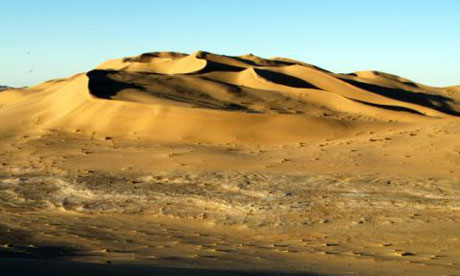
Government investment worth £50bn would
convince private companies that power from the Sahara solar scheme is feasible
and attractive option, expert says
Sand dunes stretch into the distance on the
northern edge of the Sahara desert at al-Ramla in western Libya Feb. 2,
2004. Since the government of Moammar Gadhafi began its campaign to open
its doors to the outside world, tourists are increasingly visiting Libya.
Experts say only a fraction of the Sahara,
probably the size of a small country, would need to be covered to produce
enough energy to supply the whole of Europe.
European countries could transform their electricity
supplies within a decade by investing in a giant network of solar panels
in the Sahara desert, an expert told a global warming conference in Copenhagen
today.
Dr Anthony Patt of the International Institute
for Applied Systems Analysis in Africa said some £50bn of government
investment was needed over the next decade to make the scheme a reality.
That would convince private companies that power from the Sahara was both
feasible and an attractive investment, he said.
In the long term, such a plan, combined with
strings of windfarms along the north Africa coast, could "supply Europe
with all the energy it needs".
He said technological advances combined with
falling costs have made it realistic to consider north Africa as Europe's
main source of imported energy. |
"The sun is very strong there and it's
very reliable. There is starting to be a growing number of cost estimates
of both wind and concentrated solar power for North Africa....that start
to compare favourably with alternative technologies. The cost of moving
[electricity] long distances has really come down."
He said only a fraction of the Sahara, probably
the size of a small country, would need to be covered to produce enough
energy to supply the whole of Europe.
The results are the first findings of a major
research effort, together with experts at the European Climate Forum and
the Potsdam Institute for Climate Impact Research, to judge whether such
a Sahara solar plan is realistic.
Patt said the team was looking at questions
of security and governance, as well as ways to pay for the technology.
The full results will be presented to governments later this year.
He said sunshine in the Sahara is twice as
strong as in Spain and is a constant resource that is rarely blocked by
clouds even in the winter.
The scheme would use mirrors to focus the
sun's rays onto a thin pipe containing either water or salt. The rays boil
the water or melt the salt and the resulting energy used to power turbines.
Unlike wind power, which usually has to be
used immediately because of the cost of storing the electricity generated,
the hot water and salt can be stored for several hours.
Trials of such concentrated solar power
plants are planned for Egypt, Morocco, Algeria and Dubai, but Libya and
Tunisia could also be considered.
Patt said that starting such a scheme would
not be all plain sailing though. There would likely be opposition from
local communities across Europe who unhappy about transmission cables installed
near their homes. Piecemeal national transmission networks could also pose
a problem.
The findings were revealed at the Copenhagen
Climate Congress, a special three-day summit aimed at updating the latest
climate science ahead of global political negotiations in December over
a successor to the Kyoto treaty. |